Abstract
Suspended solids (SS) composed of micrometer-to-nanometer-scale particles, including silt and organic matter, significantly impact aquatic ecosystems through physicochemical interactions. Accurate monitoring of SS concentration and particle size is critical for environmental protection and pollution prevention. We constructed multiple datasets using received signals after propagation through different aqueous environments. Analysis of the performance of neural networks across different datasets revealed that high-frequency signals with rich spectra have high potential for detecting suspended solid information in complex aqueous environments. Our study explores the performance of two neural networks (Conv1dBGRU and TCN) in combination with channel attention mechanisms in classification tasks focused on the concentration of suspended solids and particle size. We also constructed neural networks for multi-task learning using both hard and soft parameter-sharing methods to simultaneously complete the classification tasks for concentration and particle size. The results show that multi-frequency acoustic signals in combination with neural networks can achieve simultaneous and accurate estimation of the concentration of suspended solids and particle size.
1. Introduction
Suspended solids (SS) is a term referring to fine particulate matter that primarily exists in rivers, lakes, and oceans in the form of aggregates or complexes and typically consists of silt and organic materials with dimensions ranging from micrometers to nanometers. With increasing human activity and industrial development, water bodies are increasingly frequently disturbed, leading to changes in the concentrations of suspended solids. Variations in the concentrations of suspended solids of different particle sizes can cause adverse physical and chemical changes in water bodies [1]. Monitoring the concentrations and particle sizes of suspended solids is of great significance for improving polluted marine and lake areas and predicting and preventing conditions of poor water quality.
Traditional methods for measuring the concentration of suspended solids include gravimetric sampling [2], optical turbidity measurement [3,4,5], remote sensing measurement [6,7,8], and acoustic measurement. Acoustic measurement is non-intrusive, covers a large measurement range, is not affected by biological contamination, and is not limited by water transparency, allowing for dynamic and continuous data acquisition.
In the 1950s, the use of acoustic waves was first proposed as a method for detecting suspended sediments [9]. Acoustic-scattering systems and devices for obtaining information on suspended sediments have evolved since the discovery that passing through water bodies with different levels of suspended sediment leads to differences in echo signals and now rely upon the correlation between acoustic backscatter and the concentration of suspended sediment. Currently, the most commonly used acoustic device for detecting suspended sediment in water bodies is the Acoustic Doppler Current Profiler (ADCP) [10,11,12]. During the study of single-frequency measurement of suspended sediment concentrations, it was found that attenuation of the acoustic scattering signal is affected not only by suspended sediment concentration, but also by particle size [13,14]. Measuring suspended sediment concentrations at multiple frequencies can reduce errors. Hay et al. [15,16] demonstrated that using acoustic backscatter at three frequencies can simultaneously yield estimates of the average concentration and the size of suspended sand particles. Research on Multifrequency Backscatter and Attenuation Models, along with work on experimental setups based on these models aimed at the inversion of the concentration and particle size of suspended matter in water, have become a prominent research focus [17,18]. Nevertheless, existing multifrequency backscatter and attenuation models developed through scholarly research remain insufficient to precisely characterize the properties of suspended particles in complex environments. Data-driven neural network methods [19], with their robust capacity for model fitting, exhibit substantial potential to address these limitations and advance the field.
Convolutional neural networks (CNNs) are adept at capturing local features in input data, while recurrent neural networks (RNNs) can capture sequential information and long-term dependencies in the input data. Combining the two can result in the integration of local and global information, enhancing the model’s understanding of the data. The CNN-BGRU model [20] can better handle input information at different scales, improving the model’s capacity to represent input data features. The dilated convolution in the Temporal Convolutional Network (TCN) [21] structure can capture both local and global information features in the input data, and residual connections provide the potential for building deeper networks. While distinct neural network architectures excel in specialized task domains, practical applications are more commonly characterized by multi-task integration, necessitating architectures capable of handling concurrent learning objectives. In reference [22], Caruana and Rich first proposed the hard parameter-sharing architecture for multi-task learning neural networks, demonstrating that multi-task learning in backpropagation neural networks could uncover task correlations even without explicit supervisory signals. In this hard parameter-sharing framework, models for different tasks share a common feature extractor while employing task-specific encoders and output layers to generate results tailored to individual tasks. In contrast to hard parameter-sharing architectures, the Multi-Gate Mixture-of-Experts (MMoE) framework proposed by J Ma et al. [23] represents a soft parameter-sharing architecture that explicitly accounts for hierarchical dependencies among tasks. Within this architecture, the output of a task is synthesized from multiple expert networks, whose contributions are dynamically weighted by gating signals generated through a dedicated gating neural network. While hard parameter-sharing architectures [24,25,26] and Mixture-of-Experts (MoE) soft parameter-sharing architectures [27,28,29] have been extensively studied and applied in image processing and natural language processing, this study pioneers the use of multi-task learning to simultaneously address tasks related to the inversion of both suspended-matter concentration and particle size.
High-frequency acoustics alone has limitations in accurately detecting the concentration of suspended solids and particle size due to the complex relationship between acoustic signals and particle properties. Without neural networks, the inversion of concentration and particle size relies on empirical models, which lack adaptability to varying environmental conditions. Neural networks, with their powerful pattern recognition and non-linear mapping capabilities, can effectively address these limitations. They can learn complex mappings between multi-frequency acoustic signals and particle properties, enhancing detection accuracy and robustness.
In this study, we actively sent acoustic signals through a water body containing suspended solids and used neural network-based methods to quickly obtain the concentration and particle size of the suspended solids from the received acoustic signals. The main contributions of this study are as follows:
- We constructed multiple datasets using received signals after propagation through different aqueous environments, covering various frequencies, concentrations, and particle sizes.
- We proposed two neural network architectures (Conv1dBGRU and TCN) enhanced with channel attention mechanisms for the detection of the concentration and particle size of suspended solids.
- We developed multi-task learning neural networks using hard and soft parameter-sharing methods to simultaneously complete tasks focused on the detection of concentration and particle size.
- We demonstrated that high-frequency signals with rich spectra have high potential for detecting information on suspended solids in complex aqueous environments.
2. Data Acquisition and Analysis
2.1. Data Acquisition
To characterize suspended solids in water bodies using multi-frequency acoustic information, a multi-frequency acoustic information acquisition device capable of simultaneously transmitting and receiving acoustic signals was constructed by the authors. The device consists of four pairs of acoustic transducers. The four types of underwater acoustic transducers used in our experiments are produced by Hangzhou Anbuleila Automation Technology Co., Ltd. (Hangzhou, China). The performance parameters of the transducers are shown in Table 1. Signal transmission is handled by an M2i.6022 D/A converter board (Spectrum Instrumentation, Grosshansdorf, Germany), while reception utilizes an M2i.3132 A/D converter board (Spectrum Instrumentation, Grosshansdorf, Germany). Two PCs control signal transmission and reception, respectively. The output channels of the A/D converter board are connected to the acoustic transducers. The schematic connection and actual object diagram are shown in Figure 1 and Figure 2, respectively. A total of 216 sets of received signal data were collected, covering four frequencies, nine concentrations, three particle sizes, and two types of transmitted signals. The generated digital transmission signals contained 4096 points per period. The D/A converter board sent signals cyclically, with a sampling rate of 32 MHz. The A/D converter board processed the received signals at a sampling rate of 20 MHz, resulting in data with 2560 points per period.

Table 1.
The performance parameters of the transducers.
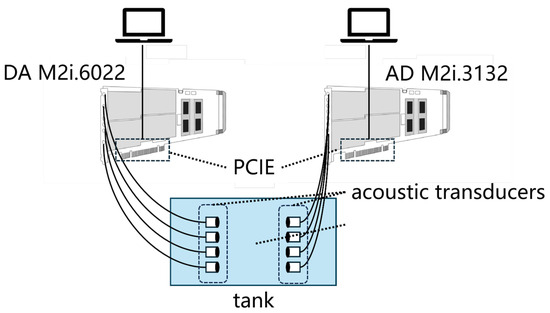
Figure 1.
Schematic diagram of data-acquisition device.

Figure 2.
Actual object diagram of data-acquisition device.
2.2. Multi-Frequency Input Features and Dataset Construction
Figure 3 illustrates the method used to construct input data samples for the neural network. Multi-channel features were constructed by allocating FFT-processed frequency bands (14 points/channel) to separate input dimensions, avoiding concatenation artifacts. The frequency band information was constructed as a multi-channel input feature by increasing the number of channels.

Figure 3.
Constructing multi-channel feature inputs using multiband received signal data.
The experimental data originated from the data-acquisition device described in Section 2.1, which was arranged with a spacing of 5 cm between each pair of transducers. The transmitted measurement signals included sine and linear frequency-modulated (LFM) signals. The received signal frequency bands covered 0.45~0.55 MHz, 0.95~1.05 MHz, 1.45~1.55 MHz, and 1.95~2.05 MHz. The concentration of suspended solids ranged from 0 mg/L to 200 mg/L; with an interval of 25 mg/L, the result is eight different concentrations. The three particle sizes considered were 400 mesh, 800 mesh, and 2000 mesh. After determining the transmitted signal for each dataset, we collected 19,000 samples of received signals in each aqueous environment. Each sample received signal was a time-series signal with a length of 2560 and a sampling rate of 20 MHz. With eight different concentration levels and three particle sizes, there were 24 types of aqueous environments. Therefore, each dataset contained 456,000 samples (calculated as 19,000 × 8 × 3). Each dataset was named based on the type and frequency band of the transmitted signal, as shown in Table 2. For example, sin-05 represents a sinusoidal signal with a frequency of 0.5 MHz; lfm-10 represents a linear frequency modulation signal with a center frequency of 1 MHz; lfm-051020 represents a linear frequency modulation signal containing three frequency bands (center frequencies of 0.5 MHz, 1 MHz, and 2 MHz).

Table 2.
Summary of datasets.
The original time-series signals had to be subjected to feature extraction before they could be effectively used for classification tasks. Signal energy, which can intuitively and simply represent the phenomenon of sound attenuation, was chosen as an indicator. We calculated the energy of each time-series signal sample using amplitude integration and analyzed the energy distribution of the dataset. Figure 4 and Figure 5 show the energy distribution of the lfm05 and lfm10 datasets, respectively, for samples with a particle size of 2000 mesh. When the transmitted signal frequency was low, the energy distribution was wider, with larger variance and more overlap. At higher frequencies, the mean energy values for different concentrations were more dispersed, individual energy variance was smaller, and energy was more concentrated. However, there is no obvious linear relationship between energy and concentration. When using Bayesian discriminant analysis for classification, we cannot distinguish among concentrations of suspended solids within the range of overlapping energy distributions. Therefore, we need neural networks to automatically extract more features that can help to differentiate among concentrations of suspended solids and particle sizes.
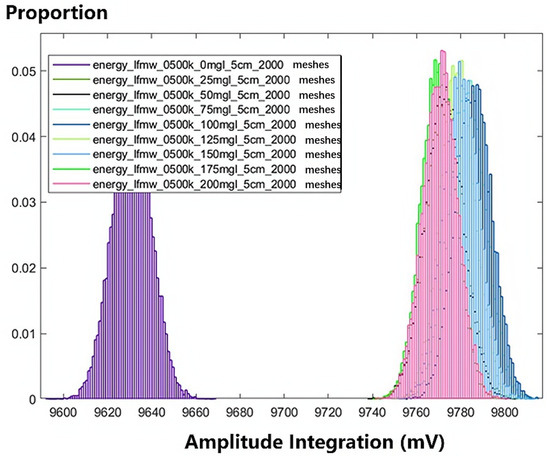
Figure 4.
The energy distribution of each concentration in the lfm05 dataset.

Figure 5.
The energy distribution of each concentration in the lfm10 dataset.
3. Neural Network Method Based on Multi-Frequency Information
3.1. Single-Task Learning Network Structure
Two neural architectures were investigated:
- Conv1dBGRU: Integrates 1D CNN for local feature extraction with Bidirectional GRU for sequential modeling
- TCN: Employs dilated convolutions to capture multi-scale temporal patterns
To address artifacts from direct frequency-band concatenation, we designed multi-channel inputs where each channel corresponded to a distinct frequency band. Three enhanced variants were developed by incorporating Squeeze-and-Excitation (SE) attention [30]:
- SEConv1dBGRU: SE layer precedes Conv1dBGRU to amplify critical frequency bands (Figure 6a).
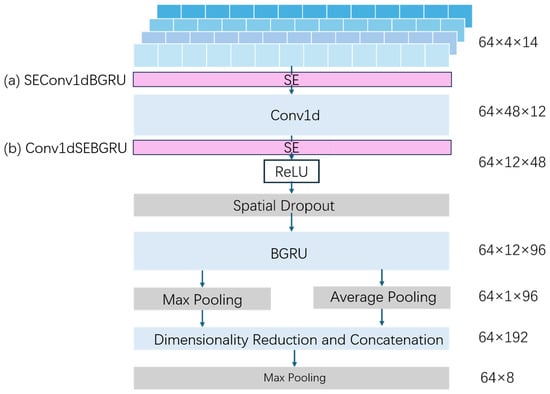 Figure 6. Two ways of combining a Conv1D-BGRU network with a channel attention mechanism.
Figure 6. Two ways of combining a Conv1D-BGRU network with a channel attention mechanism. - Conv1dSEBGRU: SE follows initial convolution to weight learned feature channels (Figure 6b).
- TCNSE: SE modules are embedded in TCN’s residual connections, enabling channel-wise attention across receptive fields (Figure 7).
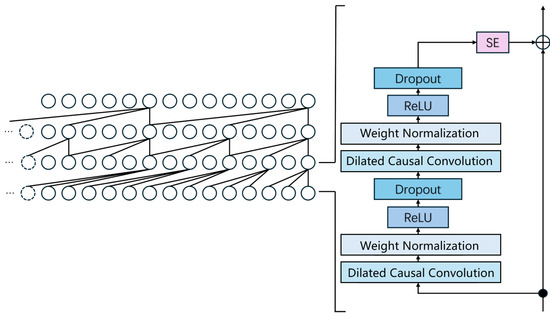 Figure 7. Temporal Convolutional Network with channel attention mechanism.
Figure 7. Temporal Convolutional Network with channel attention mechanism.
The TCNSE implementation applied SE to the first three residual layers while retaining the original structure in the final layer, balancing attention mechanisms with deep feature abstraction. Figure 6 and Figure 7 offer detailed views of SEConv1dBGRU, Conv1dSEBGRU, and TCNSE, respectively, emphasizing the integration of SE modules at different stages of the networks. These visualizations help to clarify how attention mechanisms are incorporated to improve feature-extraction capabilities.
3.2. Dual-Task Learning Parameter-Sharing Network
This study addresses the simultaneous detection of the concentration of suspended solids and particle size as accomplished through multi-task learning to mitigate network redundancy. Three key motivations drive this approach: (1) hardware efficiency for embedded deployment, (2) regularization against overfitting, and (3) potential accuracy gains from task interdependencies.
Hard Parameter Sharing: Two base architectures were extended with task-specific output layers, which were optimized via MGDA [31] to balance concentration and particle-size losses. Initial experiments revealed limited task correlation, leading to suboptimal performance compared to single-task models.
Soft Parameter Sharing: Inspired by MMoE [23], we developed two hybrid architectures:
- MG1: Dual Conv1dBGRU networks with cross-task attention gating (Figure 8)
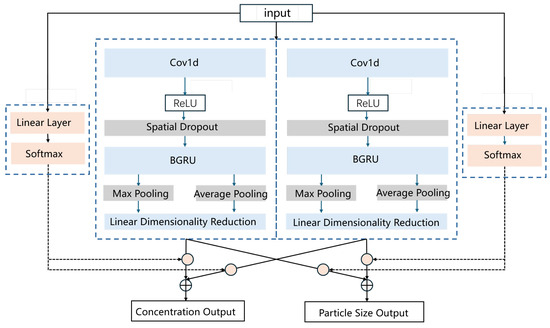 Figure 8. Two Conv1D-BGRU networks are employed to separately accomplish the tasks of determining concentration and particle-size classification, with soft parameter-sharing implemented between them.
Figure 8. Two Conv1D-BGRU networks are employed to separately accomplish the tasks of determining concentration and particle-size classification, with soft parameter-sharing implemented between them. - MG2: Conv1dBGRU-TCN ensemble with shared feature distillation (Figure 9)
 Figure 9. The Conv1D-BGRU network for concentration prediction and the TCN network for particle-size classification perform soft parameter-sharing.
Figure 9. The Conv1D-BGRU network for concentration prediction and the TCN network for particle-size classification perform soft parameter-sharing.
These designs preserve task-specific processing while enabling controlled parameter sharing through attention mechanisms, addressing the weak correlation observed in hard-sharing approaches.
4. Experiments and Results
4.1. Experimental Parameter Settings
The main basis for setting the network hyperparameters in this paper was a grid search of the learning rate, number of convolutional kernels, number of GRU hidden neurons, and number of neurons in each layer of the TCN structure. The hyperparameter combinations for the models to be trained in this experiment were determined based on the results of the grid search. The final hyperparameters used for each model are shown in Table 3. In this study, the CPU used for network training was the 12th Gen Intel(R) Core(TM) i9-12900K, and the GPU was the NVIDIA GeForce RTX 3090 Ti. The framework used for neural-network training was built using PyTorch 3.11, and related evaluation metrics were calculated with machine learning toolkits such as scikit-learn.

Table 3.
Final hyperparameters used in experiments.
4.2. Concentration Detection: Single-Task Experiment
The Conv1dBGRU, SEConv1dBGRU, Conv1dSEBGRU, TCN, and TCNSE networks were evaluated on concentration-detection tasks across multi-frequency datasets. Key observations from Table 4 include the following:

Table 4.
Networks’ performance in the classification of concentrations.
- Channel-Attention Effects: While the TCNSE model consistently outperformed TCN (e.g., +11.08% accuracy on lfm-10 dataset), SE variants of Conv1dBGRU showed few improvements, suggesting limited benefits of channel attention for Conv1dBGRU in multi-frequency scenarios.
- Frequency Dependency: Conv1dBGRU excelled with high-frequency data (99.64% accuracy on lfm-20), whereas TCNSE performed better with low-frequency data (72.63% vs. 67.23% on lfm-10).
- Multi-Frequency Advantage: Models trained on multi-band datasets (e.g., lfm-05101520) achieved >99% accuracy, significantly outperforming single-band counterparts (e.g., 39.10% on lfm-05). Results from sine-signal datasets exhibited similar trends but with lower overall accuracy and were thus omitted for brevity.
4.3. Particle-Size Detection: Single-Task Experiment
For particle-size classification (three classes), all networks achieved >98% accuracy with LFM signals due to their broadband spectral coverage, limiting comparative analysis. Therefore, Table 5 focuses on sine-signal performance, revealing the following:

Table 5.
Networks’ performance in particle-size classification.
- Frequency Impact: High-frequency bands (1.95–2.05 MHz) yielded 20.48% higher accuracy versus low-frequency bands (0.45–0.55 MHz) in Conv1dBGRU.
- Architecture Comparison: Conv1dBGRU variants outperformed TCN models by 0.07–12.27% across frequencies.
- SE Effectiveness: SE attention boosted the accuracy of the single-frequency model by 2.79% (e.g., SEConv1dBGRU on sin-05) but resulted in <1% improvement in multi-frequency scenarios.
The marginal SE benefit from multi-frequency training suggests that baseline networks sufficiently capture frequency distributions, reducing the need for explicit attention mechanisms.
4.4. Dual-Task Experiment: Detection of Concentration and Particle Size
The hard parameter-sharing networks Conv1dBGRU-h and TCNSE-h were trained using the LFM dataset. Their performances on the respective validation sets are shown in Table 5. For the hard parameter-sharing networks, the accuracy of concentration detection on the LFM validation set gradually increased with the frequency band and the accuracy of particle-size detection was almost 100% in all cases. The accuracy of concentration detection by Conv1dBGRU-h was better than that of the single-task Conv1dBGRU model, indicating that when Conv1dBGRU performed both concentration and particle size detection tasks simultaneously, the concentration-detection task could obtain additional information from the process of particle-size detection, thereby improving accuracy. The accuracy of concentration detection by TCNSE-h was not significantly better than that of the single-task TCNSE model.
The accuracy of concentration detection by the two soft parameter-sharing networks on the LFM validation set gradually increased with the frequency band, and the accuracy of particle-size detection was almost 100% in all cases. The performances of models MG1 and MG2 on the LFM validation set after training are shown in Table 6. The accuracy of concentration detection by the MG1 model in multi-task learning was almost higher than that of the single-task Conv1dBGRU model, and the accuracy of concentration detection by the MG2 model was comparable to that of the MG1 model. The performances of the two soft parameter-sharing models were better than those of the hard parameter-sharing models. Figure 10 and Figure 11, respectively, show the accuracy values and F1 scores of different models on each validation set in the form of radar charts.

Table 6.
Parameter-sharing Networks’ performance in the concentration classification.
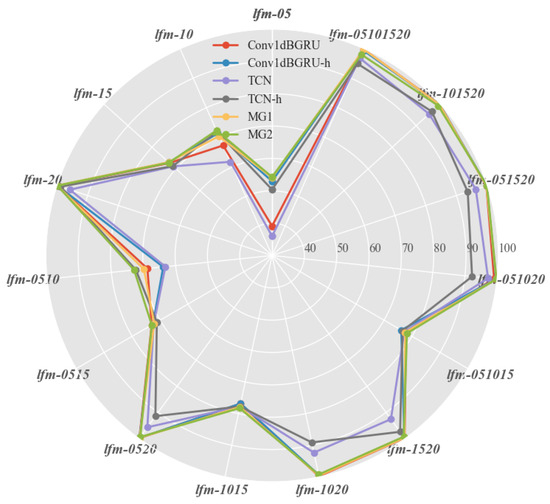
Figure 10.
The accuracy (%) of each model on each validation set.

Figure 11.
The F1-score (%) of each model on each validation set.
5. Discussion
Previous studies have shown that multi-frequency acoustic signals can improve the accuracy of methods used to detect suspended sediment (e.g., [17,18]). Our results align with these findings and further demonstrate the effectiveness of combining multi-frequency signals with neural networks. Ref. [19] highlighted the potential of machine learning methods for processing acoustic signals; our study extends that work by incorporating channel attention mechanisms and multi-task learning. For the current classification tasks, other machine learning methods (e.g., Bayesian, decision tree, and SVM classifiers) can also deliver results. However, their algorithmic complexity caps their performance. In complex water environments with suspended particulate matter, these methods cannot ensure detection accuracy. Deep neural networks with the globally dependent-capturing Transformer architecture have greater reasoning capacity. Still, they require massive datasets and immense computational resources for training and inference [32,33]. Given that neural networks must run on edge devices in practical applications, we focus our research on CNN and RNN-family neural networks. Compared to traditional methods, this study has made significant progress in the processing of multi-frequency acoustic signals and the construction of neural network models. We constructed multiple datasets using received signals after the propagation of various spectral types of detection signals through different aquatic environments. Through analysis of the performance of neural networks on different datasets, we found that spectrum-rich high-frequency signals have high potential for detecting information on suspended matter in complex aquatic environments. The comparison between Conv1dBGRU and TCN revealed that Conv1dBGRU outperforms TCN when the detection signal has fewer frequency components. However, when the detection signal contained sufficient frequency components, the performance difference between Conv1dBGRU and TCN diminished, and TCN could match Conv1dBGRU’s performance following the introduction of the SE structure. The SE structure enhanced both basic networks, but its impact was more pronounced when the network was processing single-frequency data. This is because the network can autonomously learn the feature differences of different frequency bands when multi-frequency data are input, reducing the necessity for explicit attention mechanisms. Conv1dBGRU demonstrated a stronger ability to learn these feature differences, resulting in a less significant improvement from the SE structure compared to TCN. Regarding multi-task learning, both the Conv1dBGRU and the TCN hard parameter-sharing networks effectively completed concentration classification tasks while maintaining high accuracy in particle-size classification. Although their accuracy in concentration classification was slightly lower than that obtained with independent concentration-classification tasks, the soft parameter-sharing networks MG1 and MG2 maintained the independence of the two tasks and leveraged their correlation to further enhance the accuracy of concentration classification. We believe that analysis of the performance of single-task learning and multi-task learning revealed a certain correlation between the suspended-matter and particle-size detection tasks. Only by considering the impact of both suspended-matter concentration and particle size on acoustic signals can more accurate results be obtained. Our research covers a variety of detection signals, various neural network models, and the task relevance of concentration detection and particle-size detection, filling a gap in this research field.
Despite the achievements of this study, there are also some limitations. First, in the particle-size-classification task, when the detection signal had more than two frequency components, multiple neural networks were able to achieve excellent classification accuracy on the corresponding datasets, making it difficult to distinguish among the different models in terms of their performance. The reason is that the material we used to prepare the solution included only three types of kaolin with significantly different particle sizes. Second, neural networks of the same structure showed a slight advantage in performance on multi-band datasets compared to datasets with high-frequency detection signals, which was due to the relative simplicity of the classification tasks given here. In addition, this study only configured an aquatic environment containing suspended matter of one concentration and particle size, and the ability of the model to perform in complex aquatic environments still needs further verification.
In response to the above limitations, we have identified future research directions: (1) upgrading simple classification tasks to numerical regression tasks; (2) conducting experiments in more diverse aquatic environments to verify the model’s generalization ability; (3) exploring more advanced neural network architectures to improve the model’s adaptability in complex environments.
6. Conclusions
This study used a multi-frequency acoustic-measurement device and a simulated aquatic environment to explore neural network-based methods for extracting the concentration of suspended solids and particle size from multi-frequency acoustic signals. It started with two basic networks, Conv1dBGRU and TCN, introduced channel attention mechanisms, and assessed their effectiveness in individual tasks focused on identification of concentration and classification of particle size. The results indicated that high-frequency signals with rich spectra are more suitable for detecting information on suspended matter in complex aquatic environments. Additionally, multi-task learning neural networks capable of performing both classification tasks simultaneously were developed using hard and soft parameter-sharing strategies. Overall, this research makes significant progress in the detection of suspended solids using multi-frequency acoustic signals and neural networks. By developing and evaluating various neural network models, it offers valuable insights into optimizing the use of multi-frequency signals and advanced neural network architectures for environmental monitoring. In the future, this work is expected to provide a design reference for more accurate and efficient monitoring systems in aquatic environments, thus supporting environmental protection and pollution-prevention efforts.
Author Contributions
Conceptualization and Methodology, X.Z.; Software and Data Curation, R.X.; Writing—Original Draft Preparation, Z.L.; Project Administration and Funding acquisition, G.N. All authors have read and agreed to the published version of the manuscript.
Funding
This work was supported bythe Guangdong Basic and Applied Basic Research Foundation (Grant Nos. 2021A1515110192 and 2023A1515011139) and the Science and Technology Planning Project of Guangzhou (Grant No. 2024A04J4398).
Institutional Review Board Statement
Not applicable.
Informed Consent Statement
Not applicable.
Data Availability Statement
The original contributions presented in this study are included in the article. Further inquiries can be directed to the corresponding author.
Conflicts of Interest
The authors declare no conflicts of interest.
Abbreviations
The following abbreviations are used in this manuscript:
| SS | Suspended Solids |
| D/A | Digital/Analog |
| A/D | Analog/Digital |
| ADCP | Acoustic Doppler Current Profiler |
| CNN | Convolutional Neural Network |
| RNN | Recurrent Neural Network |
| GRU | Gated Recurrent Unit |
| BGRU | Bidirectional Gated Recurrent Unit |
| TCN | Temporal Convolutional Network |
| SE | Squeeze-and-Excitation |
| MGDA | Multi-Gradient Descent Algorithm |
| MoE | Mixture-of-Experts |
| MMoE | Multi-Gate Mixture-of-Experts |
| MG1 | Multi-Gate Mixture-of-Experts Model 1 |
| MG2 | Multi-Gate Mixture-of-Experts Model 2 |
| LFM | Linear Frequency Modulated |
| FFT | Fast Fourier Transform |
| PCA | Principal Component Analysis |
| F1 | F1-score |
References
- Walch, H.; von der Kammer, F.; Hofmann, T. Freshwater suspended particulate matter—Key components and processes in floc formation and dynamics. Water Res. 2022, 220, 118655. [Google Scholar] [CrossRef]
- Larrarte, F.; Pons, M.N. Suspended solids concentration in wastewater: Influence of sampling conditions. Urban Water J. 2011, 8, 397–404. [Google Scholar] [CrossRef]
- Matos, T.; Faria, C.L.; Martins, M.S.; Henriques, R.; Gomes, P.A.; Goncalves, L.M. Development of a cost-effective optical sensor for continuous monitoring of turbidity and suspended particulate matter in marine environment. Sensors 2019, 19, 4439. [Google Scholar] [CrossRef]
- Trevathan, J.; Read, W.; Schmidtke, S. Towards the development of an affordable and practical light attenuation turbidity sensor for remote near real-time aquatic monitoring. Sensors 2020, 20, 1993. [Google Scholar] [CrossRef] [PubMed]
- Droujko, J.; Kunz, F., Jr.; Molnar, P. Ötz-T: 3D-printed open-source turbidity sensor with Arduino shield for suspended sediment monitoring. HardwareX 2023, 13, e00395. [Google Scholar] [CrossRef]
- Ha, N.T.T.; Quang, V.P.; Thao, N.T.P.; Nguyen, L.T.; Quy, T.D. Retrieval of total suspended solids from remote sensing reflectance in highly eutrophic lakes in Hanoi (Vietnam). Int. J. Remote Sens. 2022, 43, 6936–6956. [Google Scholar] [CrossRef]
- Zhang, H.; Ren, X.; Wang, S.; Li, X.; Sun, D.; Wang, L. Estimating Vertical Distribution of Total Suspended Matter in Coastal Waters Using Remote-Sensing Approaches. Remote Sens. 2024, 16, 3736. [Google Scholar] [CrossRef]
- Xie, Y.; Zhou, Y.; Tao, Z.; Shao, W.; Yang, M. Remote Sensing Inversion of the Total Suspended Matter Concentration in the Nanyi Lake Based on Sentinel-3 OLCI Imagery. IEEE J. Sel. Top. Appl. Earth Obs. Remote Sens. 2024, 17, 10380–10389. [Google Scholar] [CrossRef]
- Dietz, R.S. Deep scattering layer in the Pacific and Antarctic Oceans. J. Mar. Res. 1948, 7. Available online: https://elischolar.library.yale.edu/journal_of_marine_research/680 (accessed on 3 June 2025).
- Vergne, A.; Berni, C.; Coz, J.L.; Tencé, F. Acoustic backscatter and attenuation due to river fine sediments: Experimental evaluation of models and inversion methods. Water Resour. Res. 2021, 57, e2021WR029589. [Google Scholar] [CrossRef]
- Santos, A.I.; Oliveira, A.; Carinhas, D.; Pinto, J.P.; Zacarias, N.; Freitas, M.C. The acoustic properties of in-situ measured suspended sediments and their implications on concurrent ADCP response—Case studies of the Portuguese inner shelf. Mar. Geol. 2020, 419, 106079. [Google Scholar] [CrossRef]
- Laible, J.; Dramais, G.; Coz, J.L.; Calmel, B.; Camenen, B.; Topping, D.J.; Santini, W.; Pierrefeu, G.; Lauters, F. River suspended-sand flux computation with uncertainty estimation, using water samples and high-resolution ADCP measurements. EGUsphere, 2024; preprint. [Google Scholar] [CrossRef]
- Kytömaa, H.K. Theory of sound propagation in suspensions: A guide to particle size and concentration characterization. Powder Technol. 1995, 82, 115–121. [Google Scholar] [CrossRef]
- Al-Lashi, R.S.; Challis, R.E. Uncertainties in ultrasonic particle sizing in solid-in-liquid suspensions. IEEE Trans. Ultrason. Ferroelectr. Freq. Control 2014, 61, 1835–1845. [Google Scholar] [CrossRef]
- Hay, A.E.; Sheng, J. Vertical profiles of suspended sand concentration and size from multifrequency acoustic backscatter. J. Geophys. Res. Oceans 1992, 97, 15661–15677. [Google Scholar] [CrossRef]
- Crawford, A.; Hay, A.E. Determining suspended sand size and concentration from multifrequency acoustic backscatter. J. Acoust. Soc. Am. 1993, 94, 3312–3324. [Google Scholar] [CrossRef]
- Moore, S.A.; Coz, J.L.; Hurther, D. A Paquier Using multi-frequency acoustic attenuation to monitor grain size and concentration of suspended sediment in rivers. J. Acoust. Soc. Am. 2013, 133, 1959–1970. [Google Scholar] [CrossRef]
- Yu, H.; Tan, C.; Dong, F. Multi-frequency ultrasonic measurements of phase fraction for liquid-solid dispersions. In Proceedings of the 2020 IEEE International Instrumentation and Measurement Technology Conference (I2MTC), Dubrovnik, Croatia, 25–28 May 2020. [Google Scholar]
- Bowler, A.L.; Pound, M.P.; Watson, N.J. A review of ultrasonic sensing and machine learning methods to monitor industrial processes. Ultrasonics 2022, 124, 106776. [Google Scholar] [CrossRef]
- Zhao, N.; Gao, H.; Wen, X.; Li, H. Combination of convolutional neural network and gated recurrent unit for aspect-based sentiment analysis. IEEE Access 2021, 9, 15561–15569. [Google Scholar] [CrossRef]
- Bai, S.; Kolter, J.Z.; Koltun, V. An Empirical Evaluation of Generic Convolutional and Recurrent Networks for Sequence Modeling. arXiv 2018, arXiv:1803.01271. [Google Scholar]
- Caruana, R. Multitask Learning. Mach. Learn. 1997, 28, 41–75. [Google Scholar] [CrossRef]
- Ma, J.; Zhao, Z.; Yi, X.; Chen, J.; Hong, L.; Chi, E.H. Modeling task relationships in multi-task learning with multigate mixture-of-experts. In Proceedings of the 24th ACM SIGKDD International Conference on Knowledge Discovery & Data Mining, New York, NY, USA, 19–23 August 2018; pp. 1930–1939. [Google Scholar] [CrossRef]
- Kokkinos, I. Ubernet: Training a universal convolutional neural network for low-, mid-, and high-level vision using diverse datasets and limited memory. In Proceedings of the 2017 IEEE Conference on Computer Vision and Pattern Recognition (CVPR), Honolulu, HI, USA, 21–26 July 2017. [Google Scholar]
- Yan, B.; Chang, X.; Anastasopoulos, A.; Fujita, Y.; Watanabe, S. Cross-Modal Multi-Tasking for Speech-to-Text Translation via Hard Parameter Sharing. In Proceedings of the ICASSP 2024—IEEE International Conference on Acoustics, Speech and Signal Processing, Seoul, Republic of Korea, 14–19 April 2024; p. 10447926. [Google Scholar] [CrossRef]
- Alkhathlan, A.; Alomar, K. ArMT-TNN: Enhancing natural language understanding performance through hard parameter multitask learning in Arabic. Int. J. Knowl. Based Intell. Eng. Syst. 2024, 28, 483–495. [Google Scholar] [CrossRef]
- Mustafa, B.; Riquelme, C.; Puigcerver, J.; Jenatton, R.; Houlsby, N. Multimodal contrastive learning with limoe: The language-image mixture of experts. Adv. Neural Inf. Process. Syst. 2022, 35, 9564–9576. [Google Scholar]
- Zhao, Y.; Feng, S.; Su, D.; Yu, D. SpeechMoE2: Mixture-of-Experts Model with Improved Routing. In Proceedings of the ICASSP 2022—IEEE International Conference on Acoustics, Speech and Signal Processing, Singapore, 23–27 May 2022; p. 9747065. [Google Scholar] [CrossRef]
- Lin, B.; Tang, Z.; Ye, Y.; Huang, J.; Zhang, J.; Pang, Y.; Jin, P.; Ning, M.; Luo, J.; Yuan, L. MoE-LLaVA: Mixture of Experts for Large Vision-Language Models. arXiv 2024, arXiv:2401.15947. [Google Scholar]
- Hu, J.; Shen, L.; Sun, G. Squeeze-and-excitation networks. In Proceedings of the 2018 IEEE/CVF Conference on Computer Vision and Pattern Recognition, Salt Lake City, UT, USA, 18–23 June 2018; pp. 7132–7141. [Google Scholar]
- Sener, O.; Koltun, V. Multi-task learning as multi-objective optimization. Adv. Neural Inf. Process. Syst. 2018, 31, 525–536. [Google Scholar]
- Ali, Z. A Comprehensive Overview and Comparative Analysis of CNN, RNN-LSTM and Transformer. 2024, pp. 1–10. Available online: https://ssrn.com/abstract=5175090 (accessed on 3 June 2025).
- Ning, G.; Lin, Z.; Liao, Z.; Xiao, R. Research on Suspended Sediment Concentration Measurement Based on the Improved Attention-Convolutional Neural Networks-Bidirectional Gated Recurrent Unit Model. In Proceedings of the 2024 OES China Ocean Acoustics (COA), Harbin, China, 29–31 May 2024; pp. 1–6. [Google Scholar] [CrossRef]
Disclaimer/Publisher’s Note: The statements, opinions and data contained in all publications are solely those of the individual author(s) and contributor(s) and not of MDPI and/or the editor(s). MDPI and/or the editor(s) disclaim responsibility for any injury to people or property resulting from any ideas, methods, instructions or products referred to in the content. |
© 2025 by the authors. Licensee MDPI, Basel, Switzerland. This article is an open access article distributed under the terms and conditions of the Creative Commons Attribution (CC BY) license (https://creativecommons.org/licenses/by/4.0/).